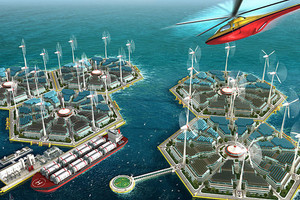
The Euro 32 million (USDol. 36 million) Hydrogen Mobility Europe programme was launched today, with Germany, the UK, the Scandinavian countries and France signing up with the aim of expanding hydrogen refuelling station coverage across the continent.

The ultimate goal of the project is to enable a network of infrastructure for hydrogen fuel cell electric vehicles (FC EVs) and work is already underway. ITM Power, the UK’s private enterprise representative in the project, has in just the past couple of weeks signed a deal with oil company Shell to put refuelling units on the forecourts of three petrol (gasoline) stations in Britain and also opened the first refuelling station on a UK motorway, the arteries of the country’s major road networks.
“We’re interested in energy storage and that’s via power-to-gas (P2G) energy storage and also refuelling stations for FC EVs. They’re our two markets,” ITM Power’s CEO Graham Cooley says.
The inception of a European network of refuelling stations, coupled with a UK policy to put dozens of refuelling stations across London, came as a good opportunity for ITM Power, which has also carried out two large-scale P2G projects in Germany which look more at the ability of the technology to balance the grid, in a similar way to how battery storage is increasingly being used. The company is also building fuelling stations in California and looking at further opportunities elsewhere. Is this potential hydrogen boom also a good opportunity for the environment and for businesses though?
Professor Christopher Hebling, expert on power-to-gas technologies at the Fraunhofer Insitute for Solar Energy, believes that it is certainly the former. He says that “in terms of the possibility and the paradigm shift which is behind it”, the technology could be a game changer. Significantly, Hebling says that in modelling greenhouse gas emissions since the early 1990s, analysts have repeatedly found that mobility was the sector of energy to make the least progress on emissions, compared to electricity networks, households, agriculture and so on. The subject has even more topical relevance this week, given the revelation that carmaker Volkswagen has admitted to using "cheating" technology to dupe emissions tests into thinking some of its diesel vehicles, which include other brands such as Audi, were emitting much less than they actually were.
In mobility, hydrogen has two key advantages over battery powered EVs. Firstly, the range once refuelled can be anything up to about 300 miles. Secondly, a FC EV can refuel in less than three minutes.
“With just these two features, high range and fast fuelling time, this will open access to all kinds of mobility, even buses, public buses and mid-class and upper-class vehicles where you want to move two tonnes and more over a few hundred kilometres, you can only do that with hydrogen,” Hebling says.

Electrolyser at hydrogen refuelling station, England. Image: ITM Power.
"A modern fairy-tale"
Fraunhofer has set up a solar PV-coupled refuelling station at Hebling’s laboratory. He says using it is akin to witnessing a “modern fairytale” in action. A PV array is connected to a polymer electrolyte membrane (PEM) electrolyser, a compressor and two dispensers. The station is publicly accessible.
“This is like a modern fairytale I would say – because there is no carbon atom involved, but there is no trailer which has to bring in any fuel. All you need is sunshine, of course the technical equipment and tap water. That’s all,” Hebling says, adding that this “technical realisation…will change the world”.
Both Hebling and Graham Cooley of ITM Power are in agreement, however, that the clean future of mobility can include both plug-in hybrids and their hydrogen counterparts. For shorter journeys, such as commuting, taking the kids to school or a weekly shopping trip, the plug-in EV is the perfect solution, for usage comparable to existing internal combustion engines, hydrogen cars can meet those Needs.

Japan is among the countries investing in hydrogen fuel cell technology, with major manufacturers including Toyota and Honda making FC EVs, seen here on display at FC Expo, Tokyo. Image: Andy Colthorpe.
Into the grid
Beyond mobility, as ITM Power’s Germany projects show, and in line with the views of many experts at this year’s Energy Storage Europe event which took place in Dusseldorf in March, power-to-gas technology also offers an opportunity to scale energy storage up to long durations and huge volumes. This could be particularly useful for grid-scale storage applications.
“In power-to-gas, what we make is passive electrolysis equipment… We can respond in less than a second to an incoming signal, which means we can do primary grid-balancing. It also means we can couple our electrolysers directly to renewable power which is absolutely fundamentally important to making green hydrogen,” says Graham Cooley of ITM Power’s approach to grid-scale storage.
“We can inject hydrogen into any part of the gas grid without needing a buffer store or a compressor. So if you have excess energy on the electricity grid that you need to store, the principle with P2G energy storage is that you turn the renewable power into renewable gas and put the renewable gas into the gas grid.”
The advantage of this, Cooley says, is that in the UK and other developed countries the gas grid is often several times bigger than the electricity grid, with commensurate levels of spare capacity.
In a similar manner to the comparison between plug-in EVs and FC EVs, Cooley says that shorter duration storage, meeting the demands of residential rooftop PV owners to self-consumer their solar for example, can be done well with solar coupled to a behind-the-meter battery.
“If you want huge, utility-scale energy storage which doesn’t last an hour but lasts days, weeks, months, even years, then that’s power-to-gas energy storage,” Graham Cooley says. “The receptor tank is the gas grid and it’s massive. A thousand terawatt-hours a year runs through our gas grid in the UK.”
In terms of pure business however, the case is still to be fully made for the technology. For fast-moving early entrants to the market like ITM Power, there are projects to be found at the macro level through initiatives such as Hydrogen Mobility Europe. Investment by major car manufacturers is picking up too, with Honda, Hyundai and others launching FC EVs. Some nations, such as Japan, are investing heavily in the technology and looking to see it scale up and for costs to come down, as we have seen in renewables.
However, as Christopher Hebling points out, the technology is still relatively expensive and will remain so for some time. While experts and analysts such as he are busy proving, researching and improving it, the speed at which this “fairytale” spreads is “for others to decide”.
“The economic part is still the weak link of the whole thing. With oil and gas prices as we have now, no technology is competitive on its own, no matter what you do. So we need more time and a better system to quantify the CO2 emissions, in terms of the certificates or carbon taxes or whatever. While this is so cheap we can do whatever we want, we just buy coal and oil and gas and burn it and so on.”
"But assuming that the world will change in this respect, that the fossil energy carrier will take a burden of the CO2 emissions and the damage they do to the climate and so on, then we’ll see more markets to come."

One of ITM Power's two power-to-gas (P2G) grid projects in Germany. Image: ITM Power.
Source
